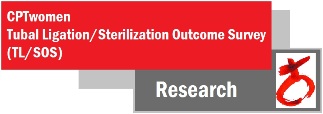|
  Sign up for the Study & Take the Survey Sign up for the Study & Take the Survey
 Registered users: Logon to the Survey Registered users: Logon to the Survey

The CPTwomen Tubal Ligation/Sterilization Outcome Health Research Study is a ground breaking research study that looks at health and other outcomes after female sterilization (tubal ligation, clips, Essure, etc…). It is the first and only research study of its kind which is independently supported by and examines first person reports by women who underwent sterilization.
Open enrollment: All women aged 18 years or older who have undergone any type of female sterilization (surgical procedure or placement of a medical device/product on or in the fallopian tubes) are invited to take part in this research study. All women are encouraged to reply. The type of sterilization does not matter. Women who have had a “tubal reversal” or Essure reversal are also invited to take the survey as health and outcome after reversals are also analyzed.
 Learn about the Primary Data and "Optional" additional information that we are seeking Learn about the Primary Data and "Optional" additional information that we are seeking
 Click here to Take the Health Survey Click here to Take the Health Survey
The research study looks at health before and outcomes after female sterilization or tubal ligation, satisfaction with the sterilization procedure (or product), and satisfaction with the consent process and medical claims which were made in advance of sterilization. First-person reports of sterilization outcomes can give valuable information about the iatrogenic effects and late sequel of sterilization, as well as changes potentially required to the public presentations and consent procedures presently offered by physicians and surgical centers.
Female sterilization by surgery (tubal ligation) and by medical devices and treatments which affect the fallopian tubes for the purpose of birth control are conceived to be permanent non-reversible forms of birth control. Tubal Ligation (TL), sometimes called tubal sterilization, female sterilization or “tying the tubes”, is a surgical procedure in which a physician seals shut a woman’s fallopian tubes. This is done surgically using coagulation (burning the tubes) (pomeroy or modified pomeroy ligation, bipolar cauterization of the tubes, or monopolar cauterization of the tubes). Female sterilization can also be done by using a medical devise such as a clip (Hulka or Filshie Clip), a ring, a band, or an Ova Bloc, Adiana, or Essure type product to seal shut and block (obstruct) the fallopian tube. Other methods of sterilization includes bilateral salpingectomy (removal of both fallopian tubes), fimbriectomy (removal of fimbrial and infundibular portions of the fallopian tube), hysterectomy (removal of the uterus), and using chemicals such as Atabrine or Mepacrine (also called quinacrine) which are place into the uterus in pellet form then dissolve and scar the fallopian tubes causing the tubes to seal shut.
Study Introduction/Purpose: The CPTwomen Tubal Ligation/Sterilization Outcome Survey is a combined observational prospective/retrospective longitudinal cohort study utilizing PRO (patient-reported outcome) data. Patient-reported outcome (PRO) data, as defined by the FDA, is “any report of the status of a patient’s health condition that comes directly from the patient, without interpretation of the patient’s response by a clinician or anyone else.” The NIH explains that PRO data is, “increasingly used to inform and guide patient-centered care, clinical decision-making, and health policy decision(s).”
This survey is being conducted independently by Susan Bucher, BSN and the CPTwomen. It examines and details PRO data and reports on women’s health status and health-related quality of life (HRQoL) before and after sterilization, satisfaction with the sterilization procedure (or product), satisfaction with the medical claims about the procedure (or product) and satisfaction with the consent process.
Being an observational cohort study it will also examine and detail over time the epidemiology of female sterilization and sudden/negative health changes (both prospectively and retrospectively) known as “post tubal syndrome” (PTS), “post tubal ligation syndrome” (PTLS), and/or “post sterilization syndrome” (PSS) and compare them to women who have not undergone female sterilization.
How the findings will be used: The results of the study will be used for scholarly purposes. Results may be presented in educational settings, at professional conferences, or published in a professional medical journals. The white paper will detail issues that directly impact post sterilized women and the results of the findings may be used to inform decision-makers and policymakers.
Click here for more information or to sign up for the health study

|